Reasons for longevity in Japan?
-
I have just read that the oldest person in the world (until her death) has passed away recently, a 116-year-old Japanese woman called Tomiko Itooka.
If you look at the oldest living people, you have five from Japan in the top 15. They also have a high life life expectancy in general, so it's not just a few outliers.
I don't pretend to understand a lot about Japanese culture, lifestyle and diet. If you look at what is generally known about the diet, some of it is interesting in terms of a bioenergetic view (probably pretty low PUFA compared to Western countries), some of it doesn't look optimal (pretty high phosphorus to calcium ratio?) The people are also good looking, mostly not overweight. I know a Japanese woman in her 50s and she looks way better than a lot of German women in their 30s. And she isn't a huge outlier.
Any idea what some of the reasons for the high longevity could be? Not just diet but also lifestyle.
Or is there some caveat and the longevity doesn't mean much because of whatever?
-
@Luke
Make a search with blue zone, to understand. -
It seems related to retirement pension fraud, where in some area they choose to not declare death of elders to continue to get money from pension.
This fraud is by far the most plausible explanation of blue zone such as okinawa or mediteranean longevity.
Charlatans took advantage of this phenomenon to promote diet program and make money with it.
-
Cremieux.xyz is a fake informative site. All it wants is to create polemics / talks about different subjects, often with 50 or 75 % of true facts, but presented to arrive to a critical conclusion. The objective is to make a buzz, to catch attention and new readers. Why? Marketing for being well-referenced. When the audience of some readers goes up, the writer / the owner of such polemics is ripe to pay to get all the advantages of the Subtracts organization.
But this "site" doesn’t yet make profit. So, your “talks” could disappear in case of bankrupt. It has taken 20 years’ time for Reddit to become lucrative / profitable. -
@Luke - Here is a List of the verified oldest people. Only 2 of the top 5 are from Japan. The oldest verified person is Jeanne Calment from France.
Was the World’s Oldest Person Ever Actually Her 99-Year-Old Daughter?
-
Boosting levels of Hyaluronic Acid (HA) to more youthful levels may be part of the key to the higher life expectancy.
Hyaluronan/hyaluronic acid (HA) is a biologically important polysaccharide molecule found in the animal kingdom, most notably in the extracellular matrix (ECM)of connective tissues and on the surface of certain pathogenic bacteria. Although HA is found in nearly every tissue of vertebrates, it is abundantly present in the extracellular matrix of soft connective tissues. In mammals, it’s predominantly found in the connective tissue of skin, testes, umbilical cord and synovial fluid.
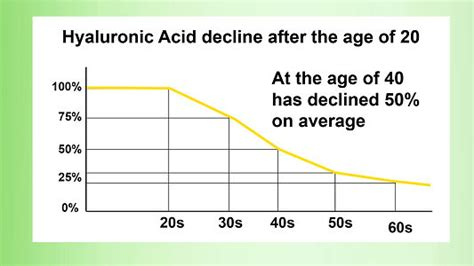
The skin care industry and the supplement industry are selling HA products to replenish the levels of HA that naturally decline with age. Mostly, to reduce wrinkles and create a more youthful appearance and also increase health span. Years ago, Connie Chung was in an ABC News interview/infomercial on the miracle of HA that may have launched the HA industry in the US. I think that the infomercial is worth watching. The marketing wizards who brought us this 'ABC News' story suggest that the long health span of the Japanese people in the video is related to the high levels of HA in their potatoes. I think that the marketers were focused on selling a value added, age-defying HA products.
ABC - Connie Chung The Miracle of Hyaluronic Acid
There are also HA preparations for osteoarthritis (OA). These HA preparations are injected directly into the area of the joint. Connie Chung was in a another 'ABC News' YouTube video that identified this medial application:
Eating a diet rich in plant flavonoids (perhaps the plants shown in the first infomercial but not mentioned as part of the solution) can also cause HA levels in the body to increase. Some of these flavonoids inhibit the activity of the enzyme hyaluronidase (HAase) which degrades HA in the body. If you inhibit the degradation of HA the levels will increase. Combining both by adding exogenous HA in the body and eating plants that contain flavonoids that inhibit the action of HAase in the body appears to be the best way to increase HA. Note - It probably best to take your HA pills separately from when you eat meals containing HAase.
From1990: Structure--activity studies of flavonoids as inhibitors of hyaluronidase. I highlighted the flavonoids from the article that were of interest to me. The highlighted flavonoids in the table all exhibited at least15% inhibition. Would it be correct to assume that their effects in the body would be additive?
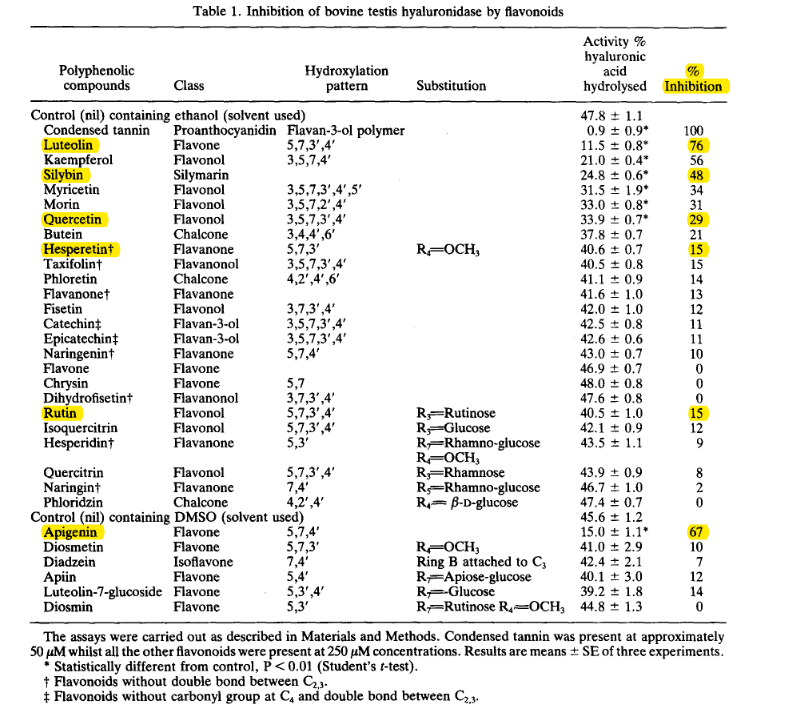
These flavonoids are not strangers to this Forum or to my diet. They may have contributed to the healing of my knee that had intermittently nagged me for a long time.
-
@LucH not crémieux, hope this is better source from your perspective:
https://www.independent.co.uk/life-style/blue-zones-netflix-ignobel-prize-b2642717.html
https://science.anu.edu.au/news-events/news/dr-saul-newman-has-uncovered-secret-living-110
-
-
I’ve only read the second link (Dr. Saul Newman). Rather cheap. I summarize: Those people have no birth certificate; so no proof for old age. The rest is blabla.
But “we” are shooting the wrong target: It’s not about centenarians (100ies) but about old aged persons fit and well in their body / mind, still active at 80ies.
Only logical.
Take this example: In Okinawa: Most people were fit in their old age but when the Americans arrived with coke and burger, the natives began to eat manufactured food. They became then obese at 40ies... -
@DavidPS
Good find. How useful and practical would it be to take inhibitors every day to reduce hyaluronidase if HA reportedly only has a half-life of 1-3 days and wouldn't it be better to raise HA synthesis rather than block its degradation?
Is there decreased HA synthesis or increased HA degradation with age? And why so?
I see genistein as a related flavone inhibits the enzyme HA synthetase 2 through protein kinase - making it important to check if any of the other substances listed in the table above do the same. Similiar to how aromatase inhibitors often act as xenoestrogens themselves and therefore result in no overall benefit. -
@CrumblingCookie - I do not think that HA is the main reason for the longevity of the people in the videos. I think the videos were designed to sell supplements. However, HA will contribute to their youthful appearance.
List Of 15 Foods High In Hyaluronic Acid
In addition, I eat foods high in apigenin. See figure 2 in Apigenin as an emerging hepatoprotective agent: current status and future perspectives (2024)
Eating healthy whole foods is important.
-
@DavidPS said in Reasons for longevity in Japan?:
@CrumblingCookie - I do not think that HA is the main reason for the longevity of the people in the videos. I think the videos were designed to sell supplements. However, HA will contribute to their youthful appearance.
List Of 15 Foods High In Hyaluronic Acid
In addition, I eat foods high in apigenin. See figure 2 in Apigenin as an emerging hepatoprotective agent: current status and future perspectives (2024)
Eating healthy whole foods is important.
Coincidentally, and anecdotally, my brother, who abuses his body with drink and little sleep, has skin that looks better than it should, for all that abuse. And the two things he eats a lot of, are #1 and #2 in that second list you provide: grapefruit and clementines. He will mix up the clementines with tangerines and mandarins (which maybe have the same nutritional value, idk).
-
@Luke I think 3 of the main factors are
1, high ergothionine intake (mauritio has a post on that),
2. a more relaxed way of being, (generally, outside of anime studios) (maybe helped created by high % of elderly population)
3. lower rates of vaccination since the 70s after children died from them and a bunch of lawsuits hit creating a more measured approach (especially with mercury being used for a while & aluminium creating extra toxic burden) (only two new vaccines were licensed in Japan between 1990 and 2007 compared to 17 in the US)https://www.youtube.com/watch?v=RfHTcloRdIU 97 year old running a restaurant (humans in true form)
-
@cs3000
Thank you. Here is the thread if other people are interested: https://bioenergetic.forum/topic/1799/ergothioneine-amino-acid-for-life-extension/14?_=1736257389403 -
Using the macro visualizer by @exfatloss you can see that 1950’s Japan and Okinawa diets consisted of shockingly high carb intake (80-85% of calories) Coming from mostly white rice and sweet potatoes. This means they ate a very low-fat (low pufa) and lowish protein diet particularly methionine/cysteine/tryptophan. This could contribute to their longevity and leanness.
-
@Serotoninskeptic
Wow, that is so interesting!Looking at the macros, they ate a very, very good diet.
In the methionine thread I've written about high carb, low protein, low fat probably being the ideal diet (but restriction 2 macros is hard) and that is pretty much what the Okinawans ate !
That also gives credit to the low protein idea being sustainable long term. Around 10% protein is what they use in a lot of studies, so that seems to be a good goal."Key nutritional biomarkers for longevity among Okinawans include lower levels of homocysteine and higher levels of antioxidant vitamins, ..."
https://en.m.wikipedia.org/wiki/Okinawa_Centenarian_Study
--> both could result from a low protein dietIirc they also have/ had higher androgens and androgenic Features than other Japanese ethnicities.
This study shows Okinawan men have higher testosterone but also higher estrogen than American men.
https://pmc.ncbi.nlm.nih.gov/articles/PMC8496353/ -
Blue zones are just a BS myth...
https://youtu.be/rB4lhT71SLo
+
https://www.dailymail.co.uk/wellness-us/article-13023311/blue-zones-healthy-life-bogus-fake-birth-certificates.html -
@Mauritio @Serotoninskeptic nice insight ty
Japanese and Okinawans were similar for averages (Okinawans had less disease too though) doi: 10.1196/annals.1396.037
(average, maximum) for Okinawans (83.8 years, 104.9 years) compared to other Japanese (82.3 years, 101.1 years),
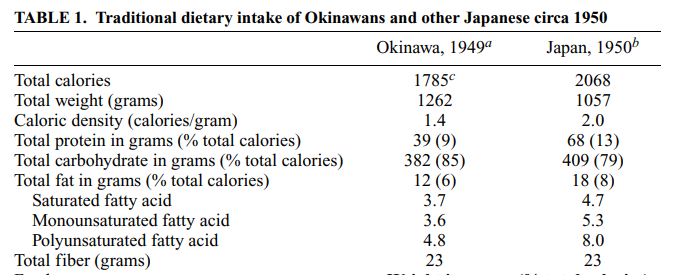
nearly 1/2 the pufa intake , relatively high for fat % but they also ate 16mg vit E which helps counter pufa vs 6mg with the other japanese (less vit E with more pufa). 9% protein & 13%.

check this https://journals.physiology.org/doi/full/10.1152/ajpregu.00834.2004
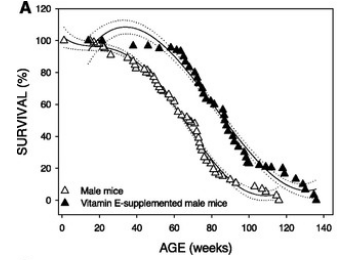
(^ I wonder if there's some exponential element to vit E need for higher pufa intake? other studies havent replicated that with lower, and their diets typically high in pufa. but rats are usually fed high vit E as a baseline already.
extreme dose not needed to counter a lot of the pufa, especially with lower intakes seen here. both also ate >200mg vit C too i think which helps vit E function, if the other japanese ate 16mg too would it have closed the disease gap a lot? which was still much better than usa)Around 10% protein is what they use in a lot of studies, so that seems to be a good goal.
this was a good one, with 10% fat and ~80% carb diet (13% as sugar), (7% protein vs 13% vs 7% + bcaa,
they added 1.8g l-cystine to 70g casein (casein doesnt have much as only protein source, some cystine needed e.g for the sulfur reactions)(mrna expression, in liver)
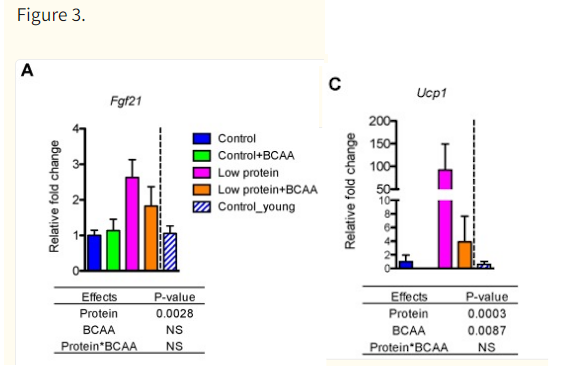
https://pmc.ncbi.nlm.nih.gov/articles/PMC6073443/#sec5-nutrients-10-00918
so 10% protein in the middle would still give a fgf21 ucp1 boosttheir lean mass & bone gain suffered on 7% but some gain
yeah bumping up to 10% might be best of both
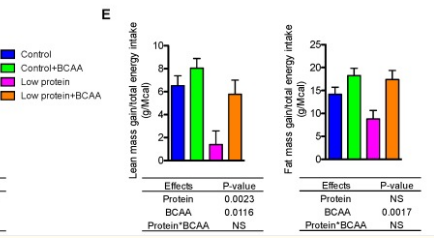
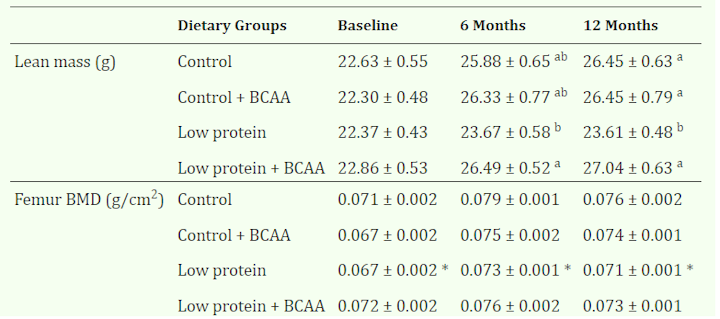
-
@Mauritio @Serotoninskeptic @cs3000
When Lindeberg examined the Kitava diet, he noticed they had a similar macronutrient ratio: ~ 70% carbs, 20% fat, 10% protein. Some fish and coconut, but mostly starchy tubers and fruit.
Do any of you remember the people Dr. Peat sometimes mentioned in interviews who ate almost nothing but potatoes/sweet potatoes all year, plus pork one week a year? He mentioned they had good muscle mass despite low protein, but I forgot whom he was talking about and I lost my notes.
-
Do any of you remember the people Dr. Peat sometimes mentioned in interviews who ate almost nothing but potatoes/sweet potatoes all year, plus pork one week a year? He mentioned they had good muscle mass despite low protein, but I forgot whom he was talking about and I lost my notes.
Could it have been the Tukisenta?
"The diet of the Tukisenta in New Guinea was studied in 1973. Their diet consists almost entirely of sweet potatoes. The Tukisenta were lean, healthy, and had little to no sign of heart disease or other diseases of civilization"